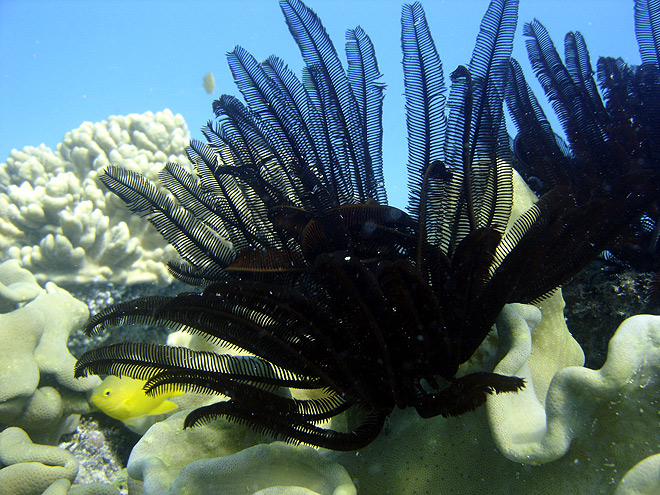Often termed lilies of the sea, crinoids, which can resemble a beautiful underwater flower, or perhaps even a creature from a Ridley Scott thriller, are amongst the oldest living creatures on earth. While suffering a major extinction episode in the Permo-Triassic, today their population remains stable, although they’ve since mostly shifted to deeper waters.

Above: Crinoid on Tongue Reef – The Great Barrier Reef, Australia.
The word crinoid comes from the Greek word krinon (lily) and eidos (form). One unusual aspect of these ancient, yet beautiful aliens of the sea, is they have a U-shaped stomach, while their anus is situated next to their mouth. And while these lilies are often attached to the bottom of the sea, they’ve been known to pull themselves along the sea floor, with one crinoid in 2005 being recorded moving at surprising speeds.
Having no true gonads, crinoids produce their offspring from genital canals, from which sperm and eggs are released into the surrounding water. The fertilised eggs then release free swimming larvae, which are able to reproduce after 10 to 16 months. Some females have even been known to brood their larvae within their long arms.
These feather-like arms are also used to filter small particles of food from the sea, while their sticky, mucus covered tube feet also trap any food that floats past. And where plankton numbers are low, crinoids generally have longer arms and stickier feet. They are also the only remaining attached suspension feeding echidnoderms in the world, and have no true stomach, as the oesophagus connects directly to its intestine.

Above: A Crinoid on Tongue Reef – The Great Barrier Reef, Australia.
The body surface of crinoids are studded with plates of calcium carbonate, which forms an exoskeleton similar to that of a star fish or sea urchin. The oldest crinoids typically possessed five arms, however modern crinoid adaptions contain ten. These arms are jointed and lined by feather-like appendages, with each arm branching several times, resulting in around 200 in total.
Stemming from the Ordovician period, crinoids are roughly 450 million years ago. And while the relatives that survive today are not exactly the same, they provide palaeontologists with a fascinating insight into the feeding habits of the only remaining attached suspension feeding echidnoderms left alive.
